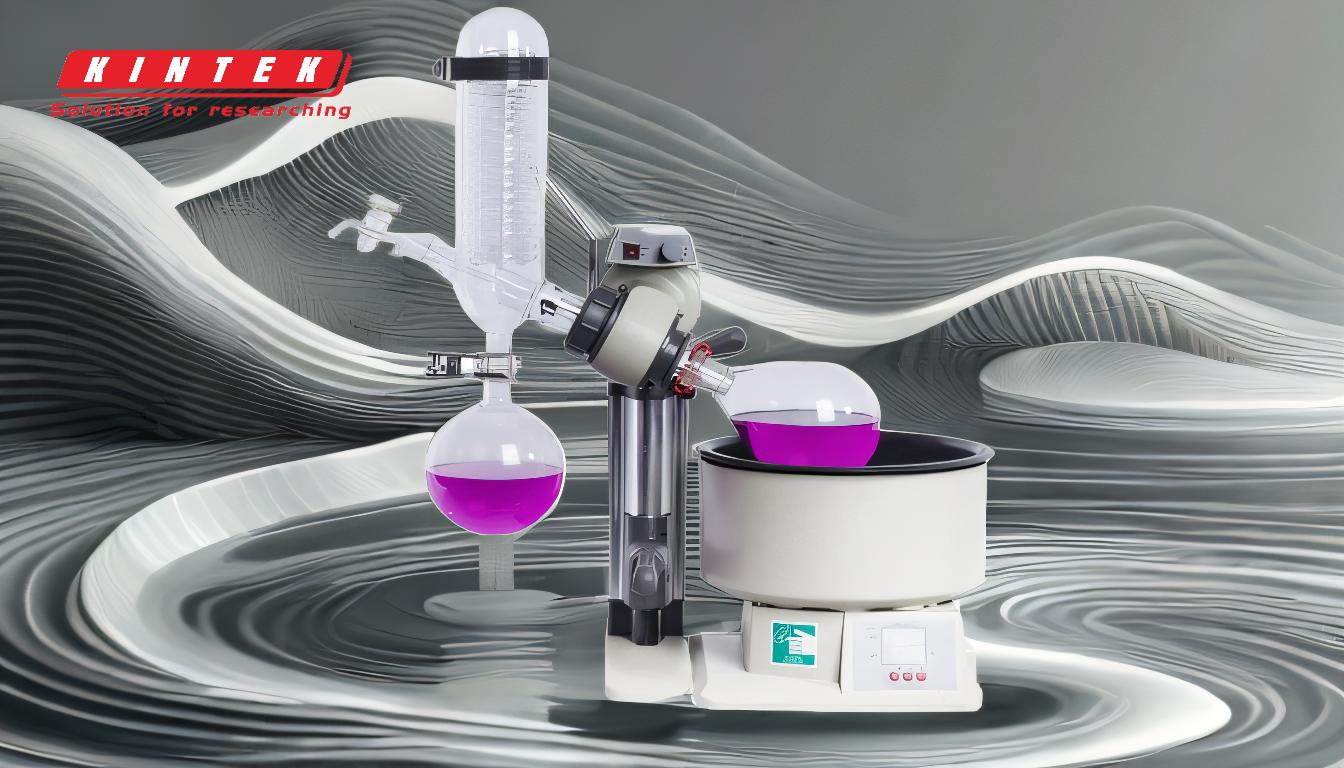A rotary evaporator, commonly referred to as a "rotovap," is a laboratory instrument designed to facilitate efficient and controlled evaporation of solvents from liquid samples. It achieves this by combining several key mechanisms: reduced pressure, rotation of the sample flask, controlled heating, and condensation. The process begins by lowering the pressure inside the system, which reduces the boiling point of the solvent, allowing it to evaporate at lower temperatures. Simultaneously, the flask is rotated to create a thin film of the sample on the flask walls, increasing the surface area for evaporation. The solvent vapor is then condensed and collected, while the solute or analyte remains in the flask. This method significantly improves evaporation efficiency, reduces processing time, and minimizes the risk of thermal degradation or bumping.
Key Points Explained:

-
Reduction of Pressure to Lower Boiling Points
- A rotary evaporator operates under reduced pressure, which is achieved using a vacuum pump.
- Lowering the pressure reduces the boiling point of the solvent, allowing it to evaporate at much lower temperatures than at atmospheric pressure.
- This is particularly useful for heat-sensitive compounds, as it minimizes the risk of thermal degradation.
- For example, a solvent that boils at 100°C at atmospheric pressure might boil at 40°C under vacuum, preserving the integrity of the sample.
-
Rotation of the Flask to Increase Surface Area
- The flask containing the sample is rotated at a constant speed by a motorized system.
- This rotation creates a thin, uniform film of the sample on the inner walls of the flask.
- The increased surface area significantly enhances the rate of evaporation compared to a stationary flask.
- This mechanism also prevents localized overheating and reduces the risk of bumping (sudden, violent boiling).
-
Controlled Heating for Efficient Evaporation
- A heated water or oil bath is used to provide consistent and controlled heating to the flask.
- The heat energy is transferred to the sample, further accelerating the evaporation process.
- The temperature of the bath is carefully regulated to ensure optimal evaporation without overheating the sample.
- This step works in tandem with the reduced pressure to achieve efficient and gentle evaporation.
-
Condensation and Collection of Solvent Vapor
- The solvent vapor produced during evaporation is directed through a vapor duct into a condenser.
- The condenser is cooled, typically using a recirculating chiller or cold water, to rapidly condense the vapor back into a liquid.
- The condensed solvent is collected in a separate flask, while the solute or analyte remains in the original flask.
- This separation process is highly efficient and allows for the recovery of solvents for reuse or disposal.
-
Advantages of Rotary Evaporation
- Time Efficiency: Rotary evaporation significantly reduces the time required for solvent removal compared to traditional methods. For instance, removing ether can take just 20 minutes instead of several hours.
- Energy Efficiency: The combination of reduced pressure and controlled heating minimizes energy consumption.
- Sample Preservation: The gentle evaporation process protects heat-sensitive compounds from degradation.
- Scalability: Rotary evaporators are available in various sizes, making them suitable for both small-scale laboratory work and larger industrial applications.
-
Applications of Rotary Evaporators
- Solvent Removal: Commonly used in chemistry labs to remove solvents from reaction mixtures.
- Concentration of Samples: Useful for concentrating solutions by evaporating excess solvent.
- Purification: Helps in isolating and purifying compounds by separating solvents from solutes.
- Distillation: Can be used for simple distillation processes under reduced pressure.
- Food and Beverage Industry: Applied in the extraction of flavors, fragrances, and essential oils.
In summary, a rotary evaporator facilitates evaporation through a combination of reduced pressure, rotation, controlled heating, and condensation. This integrated approach ensures efficient, gentle, and rapid solvent removal, making it an indispensable tool in various scientific and industrial applications.
Summary Table:
| Key Mechanism | Description |
|---|---|
| Reduced Pressure | Lowers boiling points, enabling evaporation at lower temperatures. |
| Flask Rotation | Increases surface area for faster evaporation and prevents bumping. |
| Controlled Heating | Provides consistent heat to accelerate evaporation without overheating. |
| Condensation | Cools and collects solvent vapor, separating it from the solute. |
| Advantages | Time efficiency, energy savings, sample preservation, and scalability. |
| Applications | Solvent removal, sample concentration, purification, and essential oil extraction. |
Enhance your lab's efficiency with a rotary evaporator—contact us today to learn more!










